Level 5 Leader

The Appleton Greene Corporate Training Program (CTP) for Level 5 Leader is provided by Mr. Gottfredson Certified Learning Provider (CLP). Program Specifications: Monthly cost USD$2,500.00; Monthly Workshops 6 hours; Monthly Support 4 hours; Program Duration 12 months; Program orders subject to ongoing availability.

Personal Profile
Dr. Gottfredson, Ph.D. is a cutting-edge leadership development author, researcher, and consultant. He helps organizations vertically develop their leaders primarily through a focus on mindsets. Ryan is the Wall Street Journal and USA Today best-selling author of two groundbreaking books.
He is the founder and owner of his consulting company, where he specializes in elevating leaders and executive teams in a manner that elevates the organization and its culture. He has worked with top leadership teams at CVS Health (top 130 leaders), Deutsche Telekom (500+ of their top 2,000 leaders), Experian, and others. He has also partnered with dozens of organizations (e.g., Federal Reserve Bank, Nationwide Insurance, Cook Medical) to develop thousands of mid-level managers and high-level leaders.
He is also a leadership professor at the College of Business and Economics at California State University-Fullerton. He holds a Ph.D. in Organizational Behavior and Human Resources from Indiana University, and a B.A. from Brigham Young University. As a respected authority and researcher on topics related to leadership, management, and organizational behavior, Ryan has published over 20 articles across a variety of journals including: Leadership Quarterly, Journal of Management, Journal of Organizational Behavior, Business Horizons, Journal of Leadership and Organizational Studies, and Journal of Leadership Studies. His research has been cited over 4,600 times since 2019.
To request further information about Mr. Gottfredson through Appleton Greene, please Click Here.
(CLP) Programs
Appleton Greene corporate training programs are all process-driven. They are used as vehicles to implement tangible business processes within clients’ organizations, together with training, support and facilitation during the use of these processes. Corporate training programs are therefore implemented over a sustainable period of time, that is to say, between 1 year (incorporating 12 monthly workshops), and 4 years (incorporating 48 monthly workshops). Your program information guide will specify how long each program takes to complete. Each monthly workshop takes 6 hours to implement and can be undertaken either on the client’s premises, an Appleton Greene serviced office, or online via the internet. This enables clients to implement each part of their business process, before moving onto the next stage of the program and enables employees to plan their study time around their current work commitments. The result is far greater program benefit, over a more sustainable period of time and a significantly improved return on investment.
Appleton Greene uses standard and bespoke corporate training programs as vessels to transfer business process improvement knowledge into the heart of our clients’ organizations. Each individual program focuses upon the implementation of a specific business process, which enables clients to easily quantify their return on investment. There are hundreds of established Appleton Greene corporate training products now available to clients within customer services, e-business, finance, globalization, human resources, information technology, legal, management, marketing and production. It does not matter whether a client’s employees are located within one office, or an unlimited number of international offices, we can still bring them together to learn and implement specific business processes collectively. Our approach to global localization enables us to provide clients with a truly international service with that all important personal touch. Appleton Greene corporate training programs can be provided virtually or locally and they are all unique in that they individually focus upon a specific business function. All (CLP) programs are implemented over a sustainable period of time, usually between 1-4 years, incorporating 12-48 monthly workshops and professional support is consistently provided during this time by qualified learning providers and where appropriate, by Accredited Consultants.
Executive summary
Level 5 Leader
In today’s fast-paced, complex world, only organizations with exceptional leaders thrive. With leaders capable of navigating change, fostering innovation, and empowering teams, your organization can gain an enduring competitive edge.
In Jim Collins’s seminal book, Good to Great, he calls these exceptional leaders, “Level 5” leaders. “Level 5” leaders are leaders who build enduring greatness through a blend of personal humility and professional will. They are sophisticated, adaptive, and purpose driven.
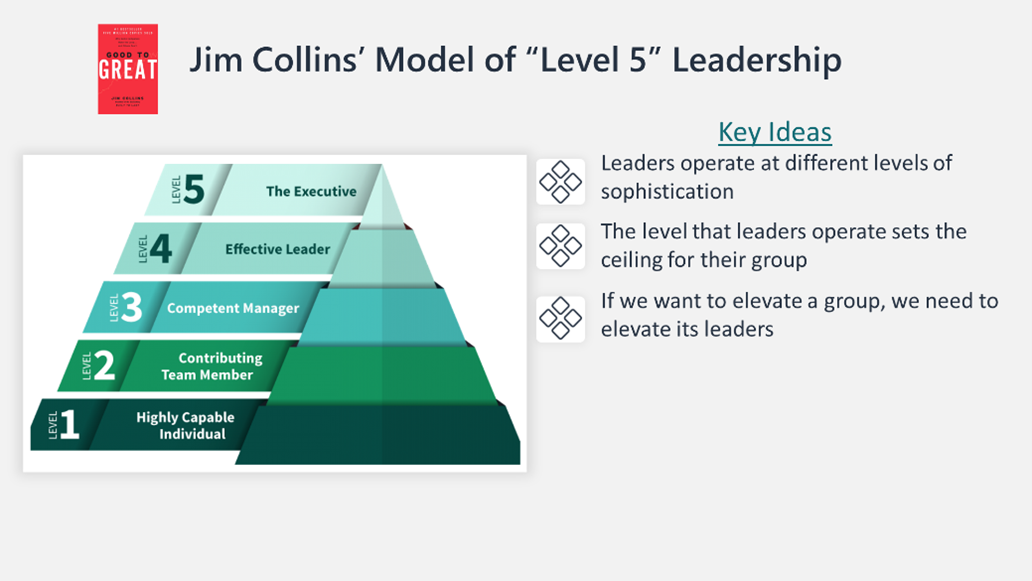
Unfortunately, “Level 5” leaders are rare. PriceWaterhouseCoopers (PwC) has reported that only 8% of leaders operate at a “Level 5” level of sophistication. The fallout of not having more “Level 5” leaders includes the following:
• 71% of organizations do not feel their leaders are able to lead their organization into the future (BrandonHall Group).
• Only 13% of executives have faith in the firm’s future leaders (The Corporate Leadership Board).
• Just 20% of employees strongly agree their performance was managed in a way that motivated them to do outstanding work (Gallup).
Yet, organizations that are successful at developing “Level 5” leaders create a competitive advantage in their marketplace because they possess leaders that can operate in a manner that is rare. They can effectively navigate complexity, establish strong and healthy accountability cultures, empower innovation, and generate long-term success.
Put in different terms, it is essential to focus on developing “Level 5” leaders because:
• Leaders operate at different levels of sophistication (“Level 3,” “Level 4,” or “Level 5”), with most leaders operating as “Level 4” leaders (85% of all leaders according to PwC).
• The sophistication of a leader sets the ceiling for the groups that they lead.
• This is because leaders develop strategies, policies, procedures, and cultures that match their level of sophistication.
• If we want to elevate an organization, division, or team, the leaders of those organizations, divisions, or teams needs to elevate their sophistication, and become a “Level 5” leaders.
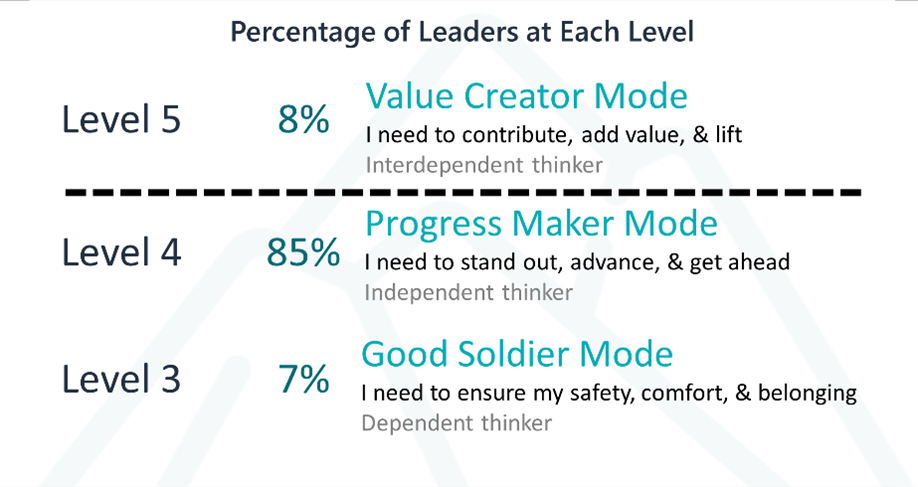
This program is designed to help your leaders level up to become “Level 5” leaders. And, the program engages in a unique, cutting-edge approach to have this impact.
Cutting-Edge Approach to Leadership Development
Not only are “Level 5” leaders rare. Leadership programs that develop such leaders are rare:
• Only 24% of executives rate their leadership development programs as effective (The Corporate Leadership Board).
• 75% of organizations rated their leadership development programs as not very effective (BrandonHall Group).
The primary reason why most leadership development programs struggle to develop “Level 5” leaders is because they (1) do not recognize that there are two forms of leadership development, and (2) they only focus on one of the two forms of leadership development.
The two forms of leadership development are:
• Horizontal Development, which involves efforts to improve leaders’ knowledge, skills, and abilities (think: downloading apps onto an iPad).
• Vertical Development, which involves efforts to reprogram the mindsets of leaders to help them shift from being wired for self-protection to being wired to value creation (think: upgrading the operating system of the iPad).
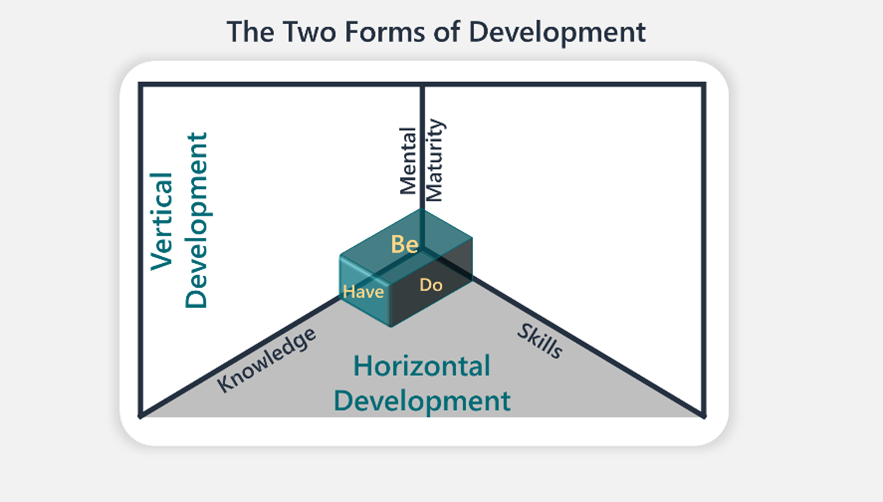
Of these two forms of development, almost all leadership development efforts focus on Horizontal Development. They try to download helpful “apps” onto leaders. This can be helpful. But, such programming often does not consider if the “operating system” of the leaders is sophisticated to employ the “apps” that get downloaded.
For example, most leaders know what emotional intelligence is and they have the ability to be emotionally intelligent (i.e., they have the emotional intelligence app downloaded onto their iPad). But, the reality is that most leaders struggle to employ their emotional intelligence “app” in conditions of complexity, ambiguity, stress, and uncertainty. This is a signal that their “internal operating system” is not very sophisticated.
In fact, it is impossible to develop “Level 5” leaders through Horizontal Development alone.
This program is unique because it has a strong focus on Vertical Development. It empowers leaders to reframe their mindset from self-preservation to value creation, enabling them to lead with resilience and strategic insight—qualities essential in today’s dynamic business environment.
In fact, Vertical Development is the focal emphasis of the first part of this program.
Program Overview
There are two parts to this program.
Part 1 – Elevating Leaders’ Level of Sophistication (Six Monthly Workshops)
Through guided self-assessment, leaders will gain awareness of their current mindset and identify blocks preventing Level 5 leadership. They’ll create actionable, personalized Vertical Development Plans, building the foundation for strategic, high-impact leadership.
Part 2 – Operating as a “Level 5” Leader (Six Monthly Workshops)
“Level 5” leaders operate in distinct ways compared to “Level 3” and “Level 4” leaders.
Here are some key distinctions that will be focused on:

Throughout Part 2, leaders will be introduced to the distinct ways “Level 5” leaders operate and then given the opportunity to practice and implement “Level 5” leadership practices within the groups they lead.
Additionally, throughout Part 2, a continued emphasis will be placed on the leaders executing their Personal Vertical Development Plan constructed in Part 1.
Program Impact
By investing in this program, you’ll transform your leaders into sophisticated visionaries who drive purpose, resilience, and results. These Level 5 leaders will elevate your organizational culture, inspire higher engagement, and achieve long-term performance gains, positioning your organization as a leader in its market.

Case Study
Research has found that only 8% of leaders operate as “Level 5” leaders. While they are few in number, there are enough that we are aware of that we can use as effective case studies. Such leaders include: Satya Nadella (Microsoft), Alan Mulally (Ford), Ginny Rometty (IBM), Ed Catmull (Pixar and Disney Animation), Reed Hastings (Netflix), and Mary Barra (GM).
One of the best examples to demonstrate the power of “Level 5” leadership is in comparing Microsoft’s current CEO, Satya Nadella, to its prior CEO, Steve Ballmer.
Steve Ballmer was the CEO of Microsoft from 2000-2014. A study of his leadership during his tenure suggests that he operated at a “Level 4.” While he was not a terrible leader, he did not operate from a very high level of sophistication. During his tenure, Microsoft’s stock price stayed essentially the same, and by the time he stepped down as CEO, market analysts were commenting about how Microsoft was growing increasingly irrelevant.
Satya Nadella has been the CEO of Microsoft since 2014. A study of his leadership suggests that he is a very sophisticated “Level 5” leader. I will highlight some of the evidence that indicate the different sophistication levels of these two leaders below. But, because Nadella operates as a more sophisticated leader, he has been able to elevate Microsoft’s strategies, structures, practices, and policies. And, as a result, Microsoft stock price is currently 9x higher than it was when he stepped in as CEO in 2014.
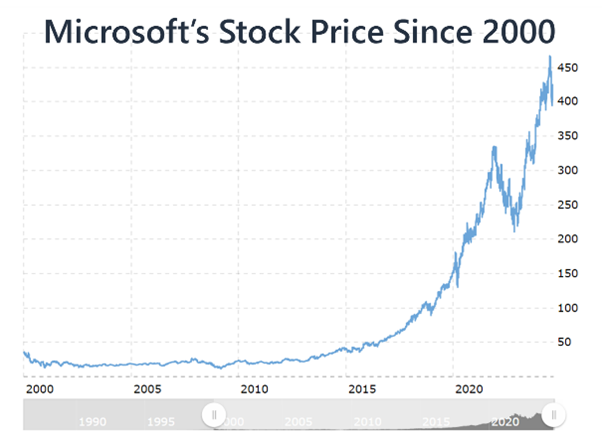
Here are some examples demonstrating how they operated at different levels of sophistication:
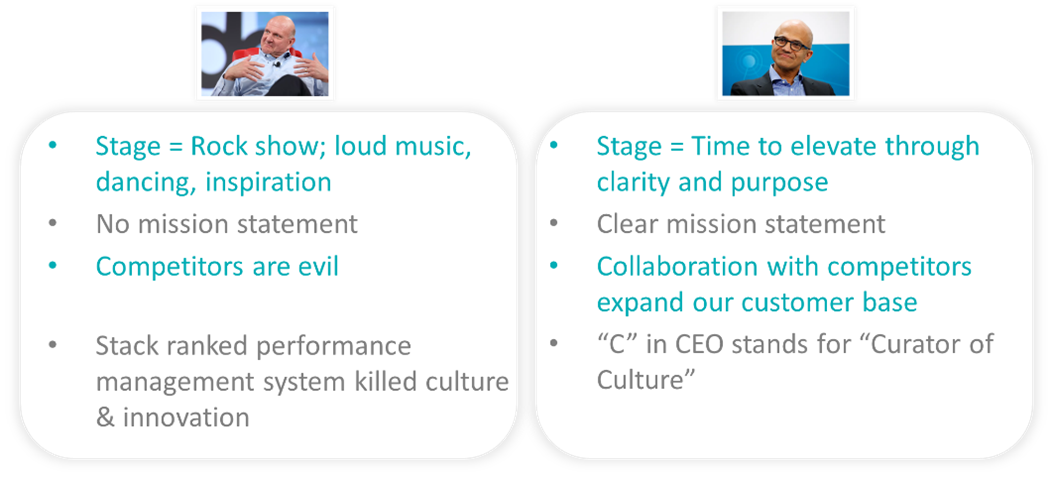
Throughout this course, I intend to share a variety of case studies like this to demonstrate the power and impact “Level 5” leaders can have. And, I will leverage these case studies to help participants gain clarity about what “Level 5” leaders do uniquely from “Level 3” and “Level 4” leaders. This will help participants gain clarity about what changes they will have to make in their leadership to operate as sophisticated “Level 5” leaders so that they can have a massive positive impact on the groups that they lead.
Curriculum
Level 5 Leader – Part 1- Year 1
- Part 1 Month 1 Mastering Self
- Part 1 Month 2 Assessing Altitude
- Part 1 Month 3 Shifting Mindsets
- Part 1 Month 4 Upgrading Systems
- Part 1 Month 5 Planning Growth
- Part 1 Month 6 Expanding Complexity
- Part 1 Month 7 Cultivating Growth
- Part 1 Month 8 Establishing Purpose
- Part 1 Month 9 Clarifying Values
- Part 1 Month 10 Building Culture
- Part 1 Month 11 Sustaining Culture
- Part 1 Month 12 Leading Change
Program Objectives
The following list represents the Key Program Objectives (KPO) for the Appleton Greene Level 5 Leader corporate training program.
Level 5 Leader – Year 1, Part 1 – Elevating Leaders’ Level of Sophistication
- Part 1 Month 1 Mastering Self – “Level 5” leadership is about becoming someone that others want to follow. In order for us to become someone others want to follow, we must become a master of ourselves. In this session, participants will discover that they have a “DOING Side” and a “BEING Side.” Our DOING Side is our level of talent, knowledge, skills, and abilities. Our BEING Side involves the programming of our body’s internal operating system. Participants will then explore the role their BEING Side plays in their “self-leadership” and leadership operations. This will be the start of a multi-stage effort to deepen participants’ self-awareness to foster self-leadership. Level 5” leadership does not come about by simply doing the “right things.” “
- Part 1 Month 2 Assessing Altitude – Leaders operate at different levels of quality and sophistication. In this workshop, participants will be able to assess their current leadership altitude (i.e., the degree to which they operate at a high-quality and highly-sophisticated level). Participants will also learn about vertical development, the key to elevating as a leader and person. This session comes with access to a personal Vertical Development Assessment.
- Part 1 Month 3 Shifting Mindsets – There are three primary distinguishing characteristics of “Level 5” leadership. In this session, we will cover the first distinguishing characteristic: Value Creating Mindsets. Participants will be introduced to the most comprehensive and research-backed mindset framework available, involving four different sets of mindsets. Each set of mindsets involves a continuum from self-protecting mindsets (fixed, closed, prevention, and inward) and value creating mindsets (growth, open, promotion, and outward). Those with value creating mindsets are more vertically developed and operate more as “Level 5” leaders than those with self-protective mindsets. Participants will not only learn about each of these mindset sets, but they will awaken to the quality of their mindsets along each of these continuums. This session comes with access to a Personal Mindset Assessment designed to help participants determine the quality of their mindsets relative to over 50,000 people who have taken the mindset assessment. This session will also set up the next session, where we will dive into the neuroscience of “Level 5” leadership.
- Part 1 Month 4 Upgrading Systems – Two other distinguishing characteristics of “Level 5” leadership are window of tolerance and emotional intelligence. When comparing “Level 5” leaders to non-“Level 5” leaders, “Level 5” leaders stand apart by having wider windows of tolerance and greater emotional intelligence. What is unique about both of these characteristics is that they are indicative of the quality of one’s internal operating system (i.e., nervous system). Thus, in this session, participants will learn what these two characteristics are, how they are connected to “Level 5” leadership and come to more fully appreciate how the process of becoming an “Level 5” leader requires upgrading their internal operating system (i.e., nervous system).
- Part 1 Month 5 Planning Growth – The prior sessions prepare participants to start doing the work of vertically development themselves. In this session, participants will engage vertical development exercise that will take them on a deep introspective dive designed to help them awaken to the mental blocks, limiting beliefs, and underlying mindsets that are holding them back from elevated leadership. After the exercise, participants will develop a personal vertical development plan that they will be asked to execute for the remainder of the program.
- Part 1 Month 6 Expanding Complexity – Vertical development research has found that as leaders “level up,” they become more complex people and beings. In fact, there are four types of complexity that they improve in: self-complexity, cognitive complexity, emotional complexity, and moral complexity. In this session, participants will learn about these four types of complexity and be guided in exercises to help them elevate their self-complexity, cognitive complexity, emotional complexity, and moral complexity to help them more effectively navigate the complexity in their life and workplace.
Level 5 Leader – Year 1, Part 2 – Elevating Leaders’ Level of Sophistication
- Part 2 Month 7 Cultivating Growth – The second part of this program will focus on how the highest-quality and most sophisticated leaders operate. And, participants will directed to take action as “Level 5” leaders. In this session, participants will study a variety of “Level 5” leaders to ascertain themes that are unique to “Level 5” leadership. One of the key themes this session will focus on is the concept of Gardener-Minded Leadership. This concept suggests that the most elevated leaders operate like gardeners, where they are primarily focused on creating an environment where their employees can grow and thrive. Additionally, this session will set up a key priority for “Level 5” leaders: Establishing a strong leadership foundation that consists of (1) creating clear, inspirational, and stakeholder-centric purpose, mission, and vision; (2) establishing clear, inspirational, and dilemma-focused values; and (3) establishing a thriving culture, each of which will be the focus for the upcoming sessions.
- Part 2 Month 8 Establishing Purpose – There are five foundational elements to establishing a strong leadership foundation. This session will cover the first three foundational elements: the establishment of clear, inspirational, and stakeholder-centric purpose, mission, and vision. Participants will learn why these elements are so critical for operating as a “Level 5” leader, and they will be directed to create clear, inspirational, and stakeholder-centric purpose, mission, and vision statements within their team or organization.
- Part 2 Month 9 Clarifying Values – There are five foundational elements to establishing a strong leadership foundation. This session will cover the fourth foundational element: the establishment of clear, inspirational, and dilemma-focused values. Participants will learn why this is the second foundational element and will be directed to create clear, inspirational, and dilemma-focused values within their team or organization.
- Part 2 Month 10 Building Culture – There are five foundational elements to gardener-minded leadership. This session will start the first half of the final foundational element: Establishing a thriving culture. Participants will learn why this foundational element is a top priority for “Level 5” leaders, and they will be directed to take action to elevate their team’s or organization’s culture. Specific aspects of culture that will be focused on in this session includes psychological safety, employee engagement, and positive relationships.
- Part 2 Month 11 Sustaining Culture – There are five foundational elements to gardener-minded leadership. This session will complete the fifth foundational element: Establishing a thriving culture. Participants will learn why this foundational element is a top priority for “Level 5” leaders, and they will be directed to take action to elevate their team’s or organization’s culture. Specific aspects of culture that will be focused on in this session includes accountability and the establishing of a proper leadership meeting cadence.
- Part 2 Month 12 Leading Change – In this culminating session, we will focus on one of the biggest challenges of sustaining “Level 5” leadership and success: Leading change. Looking back on Jim Collins’s book, Good to Great, the reality is that not many of his “great” companies are still around. This is largely because the leaders struggled to lead change effectively. In this session, we will discuss why “Level 5” leaders sometimes fail or struggle, how to avoid that, and how to ensure that they lead positive continual growth.
Methodology
Level 5 Leader
Traditional development methods fall short in preparing leaders to thrive in complex, high-stakes environments. This program’s Vertical Development approach addresses this gap by focusing not just on skills but on transforming mindsets, enabling leaders to operate at their highest potential.
Most leadership development efforts focus on a form of development called Horizontal Development. Horizontal Development involves efforts to expand leaders’ knowledge, skills, and abilities (think: downloading apps onto an iPad). Horizontal Development broadens what a leader can do but doesn’t fundamentally change how they engage with their environment.
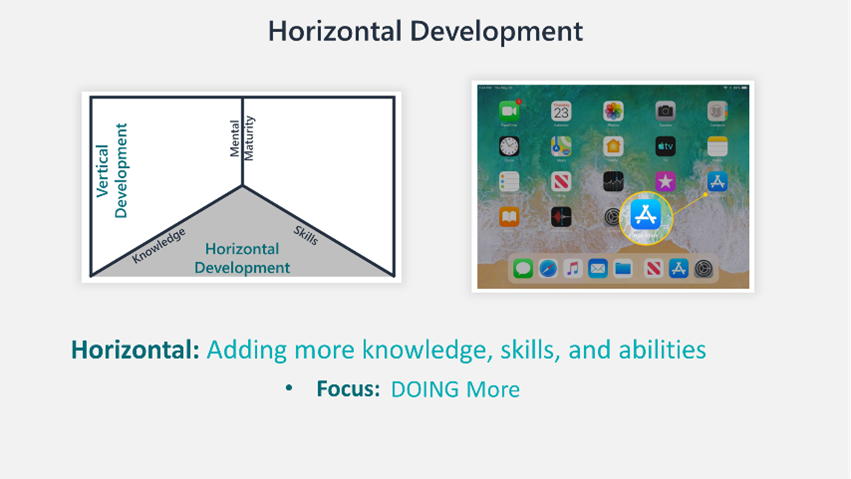
For example, a leader can learn about how to give effective feedback and can develop the skill of giving effective feedback. This is good and helpful. But, it can be limited because having knowledge and skills around effective feedback does not guarantee that the leader will give effective feedback when under conditions of stress, pressure, or complexity?
If we want to improve leaders’ capacity to perform effectively under conditions of stress, pressure, or complexity (most leadership environments), then we need a different form of development: Vertical Development.
Vertical Development transforms a leader’s core mindset, enabling them to shift from a self-protective to a value-creation orientation (think: upgrading the operating system of the iPad). This foundational upgrade empowers leaders to lead effectively even under the pressures of complexity, uncertainty, and high-stakes decision-making.
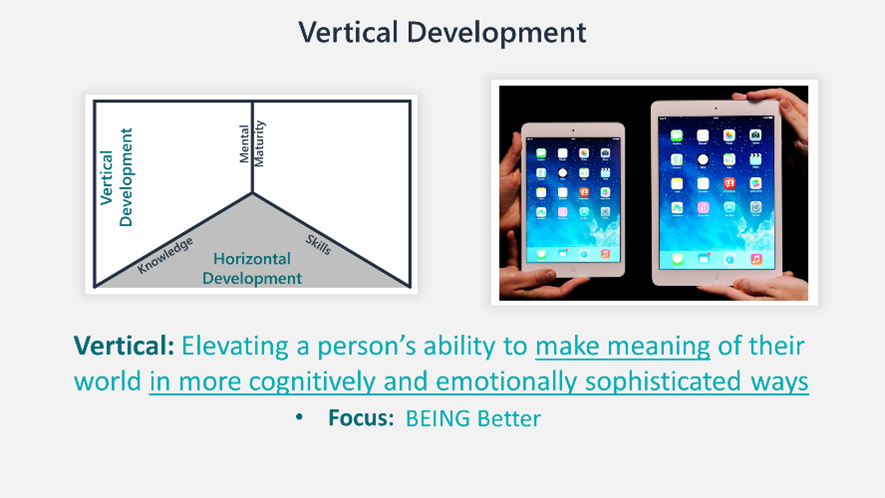
Part 1 – Elevating Leaders’ Sophistication (How Vertical Development Works)
This program leads participants through four key steps to achieve a lasting transformation in their leadership sophistication:
• Understand Leadership Levels – Gain insight into different leadership sophistication levels and recognize what “Level 5” leadership looks like.
• Assess Current Mindset – Evaluate the quality of their current “operating system” with our proprietary assessments.
• Identify Mental Blocks – Deepen self-awareness by identifying mental blocks and self-protective tendencies that are holding them back from elevated leadership.
• Develop a Personal Vertical Development Plan – Create a targeted, actionable plan to elevate to “Level 5” leadership.”
These efforts will be the primary focus of the first Part of this program (the first six of 12 overall workshops). Then, throughout the second Part of the program (the last six of 12 overall workshops), the participants will be given direction and support while they execute their Personal Vertical Development Plan.
The result of this Vertical Development process will be a transformational upgrade in leaders’ sophistication.
Part 2 – Embedding “Level 5” Leadership Practices
To ensure leaders operate as “Level 5” leaders, the second part of the program focuses on helping leaders actively practice and internalize “Level 5” operation. Specifically, participants will:
• Gain a clear understanding of the distinct ways “Level 5” leaders operate compared to “Level 3” and “Level 4” leaders.
• Be guided in practicing and implementing the distinct practices of “Level 5” leaders.
These efforts will help ensure that the Vertical Development work in Part 1 translates into actual elevation in the leaders’ operation with the groups that they lead.
Program Outcomes
Upon completion, leaders will undergo a comprehensive evaluation to measure:
• Vertical Development Growth – The degree to which their mindset sophistication has evolved.
• Application of Level 5 Practices – The extent to which they’re now embodying and sustaining Level 5 behaviors in their leadership roles.
Industries
This service is primarily available to the following industry sectors:
Healthcare
The last 30 years have seen unprecedented complexity emerge within the healthcare industry, fueled by rapid technological advancements, evolving regulations, changing payment models, and shifting patient expectations. This heightened complexity has made it increasingly difficult for healthcare organizations to navigate effectively, placing immense pressure on leadership to make sense of an ever-shifting landscape.
Starting in the 1990s, the industry grappled with soaring costs and the initial phases of managed care, which was introduced as an attempt to streamline expenses while maintaining quality. The managed care model added a layer of operational complexity by forcing healthcare organizations to work within more restrictive budgets and adhere to insurance-based care guidelines. This model required leaders to balance financial discipline with patient outcomes, demanding a level of adaptability that was new to many in the field.
With the dawn of the 21st century, technological advancements added a further layer of complexity. The introduction of electronic health records (EHRs) was initially heralded as a way to improve patient data access and sharing, yet EHR implementation was often costly and difficult to integrate across disparate systems. The Health Information Technology for Economic and Clinical Health (HITECH) Act of 2009 accelerated EHR adoption but also introduced issues around data privacy, security, and interoperability—requiring leaders to develop new skills in digital management and compliance with regulations such as the Health Insurance Portability and Accountability Act (HIPAA). Leaders were suddenly responsible not only for patient care and clinical outcomes but also for overseeing secure, efficient data management systems—an entirely new frontier in healthcare.
The passing of the Affordable Care Act (ACA) in 2010 introduced further changes, as healthcare shifted toward value-based care models. This movement emphasized patient outcomes over service quantity, pressuring leaders to improve quality while managing costs. Traditional fee-for-service models were replaced by systems where payments were linked to quality metrics and outcomes, requiring leaders to strategize more holistically across finance, patient care, and operational efficiencies. These changes fundamentally redefined healthcare leadership, as executives had to learn to navigate partnerships with insurers, adapt to fluctuating reimbursement rates, and oversee patient-centered care delivery models.
More recently, the COVID-19 pandemic acted as a catalyst for even greater complexity. Overnight, healthcare organizations were forced to adopt telemedicine, remote patient monitoring, and digital health tools to manage patient care. These changes not only tested the adaptability of healthcare leaders but also highlighted the critical need for leaders with the ability to manage unprecedented crises, leverage technology, and maintain focus on quality care amid a global health emergency.
Today, healthcare leaders must navigate a web of challenges that includes regulatory compliance, cost constraints, digital transformation, patient-centered care, and crisis management. The industry’s fast-paced evolution has highlighted the necessity for sophisticated, adaptable leadership. Leaders in this sector need a high degree of cognitive and operational sophistication to make informed, strategic decisions in this multi-faceted environment.
The future of healthcare will demand sophisticated leadership to navigate rapid technological advances, demographic shifts, and rising patient expectations. Digital health innovations like telemedicine, AI diagnostics, and remote monitoring hold transformative potential but introduce challenges around data security, interoperability, and ethical standards. Additionally, an aging population will heighten demand for chronic and long-term care, requiring leaders to manage resources and workforce needs efficiently. Value-based care models will further push leaders to balance cost and quality, addressing health disparities and social determinants of health. As regulatory scrutiny intensifies and public accountability increases, “Level 5” leaders will be essential to driving responsible innovation, ensuring equitable access, and upholding patient-centered care.
In all, the healthcare industry has experienced a vast amount of change, and it appears that the rate of change is only accelerating. This is going to require that organizations will have an increasing need for “Level 5” leaders. This “Level 5” Leadership development program is uniquely designed to develop such leaders because it leverages vertical development to help leaders develop the elevated mindsets necessary to navigate the industry’s inherent complexity. Leaders who can elevate their thinking and adapt to these complexities will be essential to the future success and resilience of healthcare organizations.
Banking & Financial Services
The financial services industry has experienced profound changes over the past 30 years, fueled by globalization, rapid technological advancement, and evolving regulatory environments. These factors have created a highly complex and competitive landscape, posing unique challenges for organizations seeking stability and growth. This increasing complexity underscores the need for sophisticated leadership capable of navigating high-stakes environments and adapting to continual disruption.
In the 1990s, deregulation played a significant role in reshaping financial services. The repeal of the Glass-Steagall Act in the United States, which had previously separated commercial and investment banking, led to the rise of financial conglomerates that combined multiple financial services under one corporate roof. This change allowed financial institutions to diversify their services, leading to growth but also introducing systemic risks by intertwining investment activities with traditional banking services. Leaders during this period had to adapt quickly, overseeing diversified operations and managing heightened financial risks across various sectors.
As the early 2000s unfolded, the rapid expansion of technology in finance—particularly through online banking and digital trading platforms—brought another layer of complexity. Innovations like high-frequency trading and algorithmic trading accelerated financial transactions but also contributed to volatility and market risk. Leaders had to grapple with an evolving competitive landscape, where agility and technological expertise became critical. These changes demanded that leaders not only understand finance but also technology, as decisions increasingly hinged on data analytics, cybersecurity, and the management of complex IT infrastructures.
The 2008 global financial crisis marked a turning point for the industry, exposing the risks of excessive leverage, lax regulatory oversight, and poor risk management practices. The crisis resulted in massive regulatory overhauls worldwide, including the Dodd-Frank Act in the United States and the introduction of Basel III requirements globally, which mandated stricter capital and liquidity requirements for financial institutions. Leaders in the post-crisis era faced increased regulatory scrutiny and were tasked with rebuilding public trust, requiring a shift toward a more transparent and risk-averse approach to management. Compliance, risk management, and ethical accountability became central priorities, and leaders were now responsible for navigating a maze of regulations and aligning their organizations with more stringent industry standards.
In recent years, the rise of fintech has introduced further complexity to the industry. Fintech innovations, including mobile payments, peer-to-peer lending, and blockchain technology, have disrupted traditional financial services, introducing new competitors and shifting consumer expectations. Established financial institutions have had to adapt to a digital-first approach, emphasizing customer-centricity and seamless digital experiences. Additionally, the widespread adoption of artificial intelligence and machine learning has transformed areas like fraud detection, credit scoring, and customer service, requiring leaders to possess a nuanced understanding of both technology and compliance.
The financial services industry today is defined by regulatory pressures, technological transformation, and increased competition from non-traditional players. Leaders in this sector are tasked with balancing regulatory compliance, cybersecurity, and operational efficiency while meeting evolving customer demands. These factors have made the industry significantly more complex than it was just a few decades ago, with financial services organizations requiring leaders who can navigate this intricate, high-stakes landscape.
The financial services industry faces a future shaped by accelerating digital transformation, regulatory evolution, and rising consumer expectations, all of which will require advanced leadership. Emerging technologies like blockchain, AI, and machine learning are disrupting traditional financial models, enabling innovations in payments, lending, and investment management but also introducing new security and regulatory challenges. Leaders will need to navigate the complexities of data privacy, cybersecurity, and evolving compliance standards, as well as manage risks associated with digital assets and decentralized finance. Additionally, consumer demand for personalized, transparent, and accessible services is reshaping the industry, requiring leaders to build agile, customer-centric organizations while maintaining ethical standards and long-term stability. As climate concerns drive sustainable finance initiatives and impact investment, elevated leaders will play a crucial role in balancing profitability with social responsibility, guiding their organizations toward a future that is both innovative and resilient.
Altogether, there is an increasing need in the financial services industry for leaders who possess the mindsets and cognitive sophistication to be able to effectively navigate the inherent complexities of the industry. This “Level 5” Leadership program will help equip your leaders with the strategic vision and adaptability required to manage risk, oversee technology integration, and drive innovation so that the organizations can thrive amid the rapid changes and uncertainties that characterize modern finance.
Technology
The technology industry has transformed remarkably over the past 30 years, evolving from a niche sector into a global powerhouse that drives innovation across nearly every other industry. Fueled by rapid advancements in computing, telecommunications, and data science, the industry has reshaped how businesses operate, how individuals interact, and how information is created and shared. These shifts have created a highly dynamic and complex landscape, presenting unique challenges for leaders tasked with navigating constant change and driving sustained growth.
In the 1990s, the technology industry was dominated by advancements in personal computing and the internet. The release of the World Wide Web in 1991 revolutionized global communication, making information more accessible and creating the foundation for e-commerce and digital media. This period saw explosive growth, with tech companies like Microsoft, IBM, and emerging startups positioning themselves as industry leaders. Leaders of technology companies in the 1990s were primarily focused on capitalizing on these new markets, building out infrastructure, and managing rapid scale, often prioritizing innovation and market expansion over stability.
The early 2000s brought the “dot-com bubble” and subsequent crash, exposing vulnerabilities in speculative investments and underscoring the need for more sustainable growth strategies. As the bubble burst, technology leaders were compelled to adopt more disciplined management approaches, with a renewed focus on profitability, accountability, and resilience. Surviving companies emerged stronger, while new companies like Google and Amazon capitalized on a maturing internet ecosystem. This era also saw the rise of cloud computing, which transformed how businesses operated by enabling scalable, on-demand resources and catalyzing the shift toward digital-first business models.
In the 2010s, the advent of mobile technology, social media, and big data analytics further transformed the technology landscape. The rapid proliferation of smartphones and mobile applications allowed technology companies to reach billions of consumers worldwide. This period was marked by the dominance of platform-based companies such as Apple, Facebook, and Twitter, whose influence extended beyond technology into social, cultural, and political realms. The explosion of data generated by digital interactions created new opportunities for innovation but also presented challenges around data privacy, security, and regulation. Leaders now needed to develop skills in managing these new regulatory demands and addressing public scrutiny while fostering innovation.
The past decade has seen exponential growth in artificial intelligence (AI) and machine learning (ML), enabling advancements in fields like autonomous vehicles, predictive analytics, and personalized healthcare. However, the rapid pace of AI innovation has also introduced ethical and practical concerns, from algorithmic bias to the future of work in an increasingly automated world. Moreover, the COVID-19 pandemic accelerated digital transformation across industries, increasing demand for cloud computing, remote work technologies, and cybersecurity measures. These changes have created a complex environment where technology leaders must stay agile and anticipate rapid shifts, balancing innovation with ethical and regulatory considerations.
Today, the technology industry is characterized by fast-paced innovation, regulatory challenges, and high competition. Leaders must navigate a landscape where technological advances outpace regulatory frameworks, requiring both adaptability and foresight. In addition, the increasing overlap of technology with other industries has heightened the complexity of stakeholder relationships, as leaders work to balance demands from users, investors, governments, and employees. With technology’s reach extending into every aspect of society, leaders must also consider the broader societal impacts of their decisions.
The technology industry’s future will be defined by rapid advancements, regulatory scrutiny, and ethical dilemmas, all of which demand sophisticated leadership. Emerging fields like artificial intelligence, quantum computing, and augmented reality have the potential to revolutionize industries, yet they also present challenges related to privacy, data security, and ethical use. Leaders will need to navigate increasingly stringent global regulations, including data protection laws and AI governance, ensuring innovation aligns with compliance and public trust. Furthermore, as technology companies continue to shape social dynamics, leaders must address concerns about misinformation, mental health impacts, and digital equity, fostering responsible practices that protect users while supporting growth. Sustainability is also becoming a priority, as climate-conscious consumers and stakeholders demand greener operations and products. In this evolving landscape, leaders who can combine technological vision with ethical foresight and adaptive strategies will be essential to building resilient, responsible, and inclusive technology-driven futures.
Understanding the context of the past, present, and future highlights the relevance of the “Level 5” leadership development program for technology leaders. By fostering advanced cognitive skills and a forward-thinking mindset, this program prepares leaders to navigate the fast-evolving technology landscape. Leaders equipped with this elevated perspective are better positioned to manage risks, drive innovation, and make ethically sound decisions—qualities that are essential for long-term success in the technology industry.

Government
Over the past 30 years, the government sector has undergone significant changes, shaped by globalization, technological advancements, and shifting public expectations. These changes have introduced new complexities and challenges for government leaders, requiring a more sophisticated approach to leadership that balances regulatory responsibilities, fiscal accountability, and the evolving needs of diverse communities.
In the 1990s, government operations began to modernize in response to the rise of digital technology. Governments at all levels started adopting digital systems to improve efficiency, simplify record-keeping, and offer basic public services online. During this period, the focus was primarily on digitizing existing processes, such as tax filings and public record management, with the goal of reducing costs and enhancing transparency. Leaders were tasked with navigating the early stages of digital transformation, while also balancing traditional bureaucratic structures that were often slow to adapt to change.
The early 2000s saw a renewed emphasis on efficiency, accountability, and transparency, largely driven by public demand for more responsive and responsible governance. This era introduced performance-based budgeting and outcome-focused strategies that required government leaders to demonstrate tangible results and effective use of taxpayer funds. In addition, major regulatory reforms in sectors like finance and healthcare meant that government leaders had to coordinate across agencies and work closely with the private sector to ensure compliance. These reforms called for leaders who could handle complex policy frameworks and work collaboratively with various stakeholders.
The aftermath of the 9/11 attacks and subsequent geopolitical shifts led to a new focus on security and emergency preparedness, especially in areas like homeland security, defense, and infrastructure. Government leaders were required to implement policies that addressed national security threats while also protecting civil liberties. This era underscored the need for leaders capable of handling crisis management and balancing conflicting priorities—an essential skill in the government sector’s increasingly complex operating environment.
In the 2010s, the digital transformation of government services accelerated with the rise of e-government and the adoption of big data and analytics to improve decision-making. Government agencies began implementing cloud computing, mobile applications, and data-driven insights to streamline services and address issues more proactively. Additionally, the growing influence of social media reshaped government communication, enabling direct interaction with citizens but also intensifying public scrutiny. Leaders were now expected to be agile, transparent, and responsive to feedback, as citizens demanded greater access to information and a voice in decision-making processes.
The COVID-19 pandemic in 2020 posed unprecedented challenges for the government sector. Agencies at all levels had to pivot quickly to address public health crises, economic relief, and emergency services, all while adapting to remote work and digital service delivery. The crisis exposed weaknesses in government infrastructure and highlighted the need for adaptive leaders who could make timely, impactful decisions under extreme pressure. Leaders were also challenged to balance urgent, short-term needs with long-term planning, as the pandemic amplified issues such as income inequality, healthcare accessibility, and digital infrastructure gaps.
Today, the government sector is more complex than ever, facing issues such as cybersecurity threats, evolving regulatory frameworks, and increased demands for social equity and environmental responsibility. Leaders in government must navigate an environment where technological change, public expectations, and global interconnectedness converge, often with limited resources and intense scrutiny. In this context, the need for sophisticated, adaptive leadership is critical.
The government sector is poised to face escalating challenges in a future defined by digital transformation, security threats, and shifting public expectations. As technology continues to reshape public service delivery, leaders will need to manage large-scale digital initiatives—such as AI-driven analytics, smart infrastructure, and cybersecurity defenses—while safeguarding citizen privacy and ensuring equitable access to digital resources. Additionally, rising cybersecurity risks, from ransomware to data breaches, will require leaders who can implement proactive security strategies and respond swiftly to threats. Public demand for transparency, responsiveness, and social equity is also intensifying, compelling government leaders to adopt inclusive policies, address systemic disparities, and foster trust in public institutions. Climate resilience and sustainability will further push governments to lead innovative environmental efforts, from clean energy transitions to disaster preparedness. In this complex environment, elevated leaders who can manage inter-agency collaboration, drive ethical governance, and inspire public trust will be essential to navigating the evolving responsibilities of government.
Altogether, the “Level 5” Leadership development program is well-suited to set your organization up for improved navigation now, as well as into the future. This program will leverage vertical development to help your government leaders cultivate the advanced cognitive skills and elevated mindset necessary to operate in complex, high-stakes environments, make ethical and strategic decisions, and lead with resilience. Leaders with this level of sophistication are essential for guiding government agencies through today’s multifaceted challenges and ensuring effective governance in the future.

Education
The education sector has experienced profound shifts over the past 30 years, shaped by technological advancements, changing societal expectations, and evolving funding models. These changes have made the sector increasingly complex and challenging to navigate, underscoring the need for sophisticated, adaptive leadership. Education leaders today face the pressures of managing digital transformation, equity in access, regulatory compliance, and rising accountability—all within an environment that has traditionally been slow to change.
In the 1990s, education systems around the world were focused primarily on expanding access to education and increasing accountability for student outcomes. Standards-based education reform gained traction, leading to the widespread adoption of standardized testing and curriculum alignment efforts. These reforms were intended to close achievement gaps and ensure consistent education quality, but they also introduced a new layer of accountability that required education leaders to manage compliance while still supporting student-centered teaching. During this period, the demands on school administrators and higher education leaders increased significantly as they began to oversee outcomes-based metrics and negotiate budgetary constraints.
The 2000s saw a dramatic acceleration in technology adoption, with personal computers and the internet reshaping the classroom. Educational institutions began implementing digital tools to support both teaching and administrative processes, such as online resources, digital gradebooks, and email communication systems. This digital shift introduced new challenges, as leaders needed to invest in infrastructure, train staff, and address concerns about equitable access to technology. Higher education institutions, in particular, began facing mounting pressure to adopt online learning platforms as students increasingly sought flexible learning options.
The late 2000s and early 2010s brought even greater complexity with the rise of online education and e-learning platforms. The growing popularity of Massive Open Online Courses (MOOCs) and distance learning programs disrupted the traditional models of education, especially in higher education. As the industry adapted to this new reality, leaders were tasked with managing the integration of online learning within their institutions and ensuring quality in a rapidly changing instructional environment. Meanwhile, funding pressures escalated, with public institutions facing budget cuts and private institutions increasingly competing for enrollment and endowment dollars. Leaders needed to become adept at financial stewardship and strategic planning to ensure the viability of their institutions.
In recent years, there has been a growing emphasis on equity, social-emotional learning, and inclusivity within the education sector. Leaders have been called upon to address issues related to student mental health, diversity, and access to quality education, especially in response to mounting evidence that socioeconomic disparities significantly impact educational outcomes. Additionally, the COVID-19 pandemic in 2020 accelerated the digital transformation of education at every level, forcing institutions to adapt to remote learning almost overnight. This crisis highlighted existing gaps in access and preparedness, placing even greater demands on education leaders to prioritize resilience, agility, and inclusive policies.
Today, the education sector is characterized by ongoing digital transformation, financial constraints, and heightened calls for equity and accountability. Leaders must balance the needs of students, faculty, and communities in an environment that is both highly regulated and subject to changing public expectations. They are tasked with navigating technological integration, financial sustainability, and compliance with diverse stakeholders’ expectations, all while maintaining a focus on student outcomes and institutional integrity.
The education sector faces a future of profound transformation and complexity, presenting challenges that will require elevated leadership. Rapid technological advancements in AI, digital learning platforms, and data analytics are reshaping traditional education models, calling for leaders who can integrate these tools responsibly to enhance learning while addressing privacy and equity concerns. Additionally, increasing disparities in access to quality education demand leaders who can create inclusive policies that bridge socioeconomic and geographic gaps. Rising mental health challenges among students will require educational leaders to prioritize social-emotional learning and well-being alongside academic achievement. Climate change and sustainability are also becoming educational priorities, as institutions prepare students for emerging global issues. Moreover, as public accountability intensifies, leaders must navigate diverse stakeholder expectations, ensuring financial sustainability and high standards of educational quality. Leaders with advanced vision and adaptability will be crucial in steering the education sector through these challenges, creating institutions that are resilient, inclusive, and future-focused.
In this complex environment, the “Level 5” leadership development program is highly relevant. By fostering advanced cognitive skills and mindsets through vertical development, the “Level 5” leadership development program equips education leaders to handle the intricate demands of modern education. Leaders who develop this level of sophistication will be better positioned to implement sustainable changes, manage stakeholder relationships, and make impactful decisions that support both equity and innovation in education.
Locations
This service is primarily available within the following locations:

Los Angeles, CA
With a population of nearly 4 million in the city and over 13 million in the Greater Los Angeles area, Los Angeles is California’s largest metropolitan region and the second most populous in the United States. Known for its diverse economy, global influence in entertainment, and its strategic position as a Pacific Rim gateway, Los Angeles has been a key player in both national and international commerce. Over the past 25 years, the city has experienced a dynamic evolution in its economic landscape, driven by technology, trade, and creative industries, which continue to shape its commercial outlook and set the stage for future growth.
Recent Commercial History
Historically, Los Angeles established itself as a major economic center through its ports, aerospace industry, and Hollywood’s entertainment empire. In the late 20th century, however, the city began diversifying beyond its foundational industries. With the rise of global trade, the Port of Los Angeles became one of the busiest ports in the Western Hemisphere, bolstering the city’s logistics and international trade sector. This strategic positioning enabled the city to become a crucial entry and exit point for goods moving to and from Asia, creating significant employment opportunities and expanding L.A.’s influence in international commerce.
The entertainment industry has continued to grow, but it has also transformed with the advent of digital media, streaming services, and the convergence of technology and entertainment. This shift has turned Los Angeles into a global hub for digital content, drawing tech giants and startups alike to set up operations in the region. In addition, the aerospace industry, once dominated by major defense contractors, has seen a resurgence in commercial and private space exploration companies like SpaceX and Virgin Galactic. This period of growth has made Los Angeles an innovation center that integrates traditional industries with new technological ventures.
In the 2000s, the city began investing in revitalizing its urban infrastructure and attracting technology companies, which led to the development of “Silicon Beach,” an area encompassing Santa Monica, Venice, and Playa Vista. Home to over 500 tech startups, this area now serves as a west-coast alternative to Silicon Valley, drawing talent and venture capital to Southern California. The establishment of this tech ecosystem and sustained growth in tourism and creative industries have cemented Los Angeles as a multifaceted economic engine.
Current Commercial Position
Today, Los Angeles boasts one of the most diverse economies in the country, with key sectors in entertainment, technology, international trade, aerospace, fashion, and healthcare. The Port of Los Angeles, combined with the Port of Long Beach, forms the busiest container port complex in the United States, facilitating international trade valued at hundreds of billions annually. This massive trade infrastructure supports an extensive logistics and warehousing sector, making Los Angeles a critical hub for supply chain operations that reach across North America.
The entertainment industry remains an economic pillar, with L.A. housing the headquarters for major studios like Warner Bros., Paramount, and Universal. In recent years, digital content creation has expanded exponentially with streaming companies like Netflix, Amazon Studios, and Hulu establishing significant presences in the city. Los Angeles is now known not only for traditional film and television production but also as a leading center for gaming, digital media, and virtual reality, attracting global investments.
The growth of Silicon Beach has fueled the city’s reputation as a burgeoning tech center, attracting prominent tech companies such as Google, Facebook, and Snapchat, alongside countless startups in AI, cybersecurity, and fintech. Los Angeles is also making strides in clean technology and electric vehicle innovation, spurred by both government initiatives and private investments. Healthcare is another significant sector, with renowned medical institutions like UCLA Health and Cedars-Sinai Medical Center advancing medical research and biotechnology.
This diverse economic landscape requires leaders who can adapt to rapid changes in technology, navigate cross-industry collaborations, and handle global trade dynamics. Given the city’s complex business environment, leaders who are capable of forward-thinking and strategic decision-making are essential to sustaining growth in Los Angeles’s many key sectors.
Commercial Future Outlook
Looking ahead, Los Angeles faces several promising opportunities as well as pressing challenges that will require elevated leadership. The city is expected to continue its expansion in tech and digital media, with Silicon Beach projected to grow as an alternative to Silicon Valley, especially as remote work trends encourage tech talent to explore urban centers beyond the Bay Area. The city is also investing in clean energy and green infrastructure, with ambitious climate goals to reduce emissions and promote sustainable urban development. This initiative will create opportunities in green technology, renewable energy, and electric vehicles, attracting businesses that prioritize sustainability.
The 2028 Olympic Games, which Los Angeles will host, are anticipated to bring significant economic and infrastructural investments to the region. The city is expected to benefit from enhanced public transit, increased tourism, and global exposure, all of which can catalyze growth across multiple industries. This development will require leaders who can manage large-scale projects, navigate stakeholder interests, and ensure that infrastructure investments benefit the community long-term.
However, the future also presents challenges. The cost of living in Los Angeles remains high, and the region faces ongoing issues related to housing shortages and homelessness. Addressing these social issues will require leaders in both the public and private sectors to engage in innovative solutions that create affordable housing options and economic opportunities for underserved populations. Furthermore, the city’s reliance on global trade and tourism makes it vulnerable to economic disruptions, whether from supply chain issues, global health crises, or geopolitical tensions. Leaders will need to build resilient business models that can withstand these fluctuations and adapt to a rapidly changing global landscape.
Given Los Angeles’s diverse and competitive environment, the “Level 5” leadership development program is particularly suited to prepare leaders for the complexities of this city. Leaders who possess a high level of adaptability, resilience, and strategic foresight will be well-equipped to navigate Los Angeles’s multifaceted economy. By focusing on vertical development, your program empowers leaders to operate effectively across the city’s diverse sectors, drive sustainable growth, and create value in an environment characterized by constant change and opportunity.

San Francisco, CA
San Francisco, along with the surrounding region of Silicon Valley, is one of the world’s foremost centers of technology, finance, and innovation. With a population of approximately 880,000 in San Francisco and around 4 million in the broader Bay Area, this region has become synonymous with cutting-edge technology, venture capital, and a pioneering spirit that has redefined industries globally. Over the past 25 years, San Francisco and Silicon Valley have undergone rapid changes, driven by technological innovation and economic growth, creating a unique environment that requires sophisticated leadership to navigate.
Recent Commercial History
San Francisco and Silicon Valley’s economic rise dates back to the post-World War II era, but it was the technology boom of the late 1990s and early 2000s that solidified the region’s reputation as the global epicenter of innovation. The dot-com boom saw the rise of early internet companies and a wave of venture capital investment, which fueled the development of numerous startups. Although the dot-com bubble burst in 2000, leaving some companies in financial ruin, the industry rebounded quickly with the rise of major tech players like Google, Facebook, and Apple. These companies not only recovered from the downturn but ushered in a new era of digital connectivity and data-driven business models that transformed the way people live and work.
By the late 2000s and early 2010s, Silicon Valley had become home to leading tech firms in cloud computing, artificial intelligence, and mobile technology. Apple’s launch of the iPhone in 2007 marked a pivotal moment, revolutionizing personal technology and cementing Silicon Valley’s influence in the global market. The success of the iPhone catalyzed the growth of app-based companies like Uber, Airbnb, and Twitter, which established San Francisco as the headquarters for many of the world’s leading social and mobile technology companies. During this time, the region saw an influx of talent and capital, with venture capital firms heavily investing in startups that promised disruptive innovation.
The booming tech industry led to rapid economic growth and rising real estate prices, creating both prosperity and socioeconomic challenges. This era highlighted the need for leaders capable of managing rapid growth, navigating competitive pressures, and addressing the complexities of a workforce drawn from around the world.
Current Commercial Position
Today, San Francisco and Silicon Valley remain central to the global tech ecosystem. The area is home to the headquarters of major tech companies such as Google, Facebook (Meta), Apple, and Salesforce, as well as numerous startups and venture capital firms. The Bay Area alone accounted for a significant percentage of the United States’ venture capital investment, fueling industries ranging from fintech and healthcare technology to cybersecurity and autonomous vehicles. This unique concentration of resources, talent, and capital has made the region highly competitive and influential, setting trends and standards for the rest of the world.
Beyond technology, San Francisco is also a hub for finance, home to the Federal Reserve Bank of San Francisco and numerous fintech companies. The intersection of technology and finance in the region has led to a surge in financial innovation, with fintech companies developing products that are reshaping how people interact with financial services. Additionally, the Bay Area is a leader in biotechnology and life sciences, with companies like Genentech and Gilead leading breakthroughs in healthcare and pharmaceuticals.
While the region’s economic power is undeniable, it faces significant challenges, such as the high cost of living, income inequality, and housing shortages. The prosperity brought on by the tech industry has exacerbated social disparities, making affordable housing a top issue for local leaders. Traffic congestion, environmental impact, and homelessness have also become critical issues as the population grows, underscoring the need for leadership that prioritizes sustainable development and community well-being.
Commercial Future Outlook
Looking forward, San Francisco and Silicon Valley are expected to continue leading in areas like artificial intelligence, clean energy, biotechnology, and digital transformation. The region’s tech ecosystem is evolving rapidly, with emerging technologies such as quantum computing, blockchain, and machine learning poised to drive the next wave of innovation. Companies and research institutions in the Bay Area are likely to remain at the forefront of these advancements, setting the global standard for innovation and technological development. Leaders in this environment will need to balance rapid technological progress with ethical considerations, especially as AI and machine learning introduce new questions around data privacy, algorithmic bias, and job displacement.
The region’s emphasis on sustainability and environmental responsibility is also expected to grow, particularly as California pursues ambitious climate goals. Many tech companies in Silicon Valley have already committed to reducing their carbon footprint, investing in renewable energy, and developing sustainable practices. Leaders in the coming years will be tasked with finding innovative solutions to meet these sustainability goals, while also adapting to regulatory pressures aimed at reducing environmental impact.
At the same time, San Francisco and Silicon Valley face challenges that could impact long-term growth. The high cost of living and housing shortages have prompted some companies and workers to relocate to other cities, raising concerns about the sustainability of the region’s economic model. As remote work becomes more prevalent, companies may reassess the necessity of maintaining a physical presence in Silicon Valley, potentially reshaping the region’s commercial landscape. Leaders will need to address these evolving dynamics by developing adaptive strategies to retain talent, promote affordable housing initiatives, and create a balanced, community-focused approach to growth.
Given the intense competition, rapid change, and social challenges in San Francisco and Silicon Valley, the “Level 5” leadership development program is particularly relevant for organizations in this region. Leaders here must possess the cognitive sophistication to manage complex technological innovation while maintaining ethical and sustainable business practices. The program’s emphasis on vertical development aligns well with the needs of Silicon Valley leaders, empowering them to lead with resilience, navigate industry disruption, and make strategic decisions that balance growth with community and environmental responsibility. Leaders who can elevate their thinking and adapt to this high-stakes environment will be instrumental in shaping the future of San Francisco, Silicon Valley, and the broader technology landscape.
New York
New York City, with a population of over 8 million people, stands as one of the most influential economic and cultural hubs in the world. Known for its dynamic finance, media, and real estate industries, as well as its global cultural impact, the city has long been a magnet for both capital and talent. Over the past 25 years, New York’s economy has evolved in response to changing global markets, technological advancements, and demographic shifts, making it a vibrant yet challenging environment for organizations to operate. This economic complexity demands sophisticated, adaptable leadership capable of navigating a highly competitive and constantly changing commercial landscape.
Recent Commercial History
Historically, New York City’s economy was built on finance, real estate, and commerce, with Wall Street at its core. By the 1990s, New York was already a global financial capital, home to the New York Stock Exchange (NYSE) and a concentration of major investment banks, insurance companies, and asset management firms. However, the city’s economy faced challenges during this period, including the economic downturn in the early 1990s and the effects of 9/11 in 2001, which impacted the financial sector and real estate market. Yet, New York’s resilience led to a period of recovery and growth, aided by diversification efforts that saw technology, media, and healthcare industries expand significantly.
In the 2000s, New York began solidifying its position as a hub for technology and digital media, largely fueled by the rise of Silicon Alley—a tech sector that took root in Manhattan and later spread to Brooklyn. This period marked the influx of tech companies, from established players like Google to countless startups supported by a burgeoning venture capital scene. At the same time, the city remained a powerhouse in media and advertising, housing major firms like The New York Times, NBCUniversal, and WarnerMedia. New York’s economic growth during this time was also supported by its robust healthcare and education sectors, with institutions such as NYU Langone, Columbia University, and Weill Cornell Medical Center driving innovation and employment.
The financial crisis of 2008 posed significant challenges for New York, as the city’s finance-heavy economy took a major hit. However, this period also led to an increased focus on regulatory compliance, risk management, and economic resilience. The crisis prompted a wave of mergers and restructuring within the financial sector, requiring leaders to operate with a new level of fiscal responsibility and strategic foresight. The city rebounded in the following decade, with its economy continuing to diversify and a new emphasis on technology, media, and green initiatives.
Current Commercial Position
Today, New York City is an incredibly diverse economy with significant influence across finance, technology, real estate, healthcare, and the arts. Wall Street remains a central pillar of the economy, with the NYSE and Nasdaq continuing to play crucial roles in global financial markets. The city is home to major financial institutions such as JPMorgan Chase, Goldman Sachs, and Citigroup, and it serves as a hub for both domestic and international finance. However, New York has also evolved into a leading tech center, with a growing concentration of tech firms located in Manhattan, Brooklyn, and Queens. Tech giants like Amazon, Facebook, and Google have expanded their presence in the city, and the New York City Economic Development Corporation (NYCEDC) has launched initiatives to support tech startups and attract venture capital investment.
The media and entertainment sector remains integral to New York’s economy. The city is home to major networks, publishing companies, and digital media firms, making it a leading center for news, television, and advertising. The Broadway theater district, along with film and television production studios, contributes significantly to the economy and underscores the city’s status as a global cultural capital. Healthcare is another critical sector, with institutions like Mount Sinai Health System, NYU Langone, and Memorial Sloan Kettering Cancer Center leading in medical research and patient care. The real estate sector is also pivotal, driven by ongoing commercial development and demand for residential space in one of the most densely populated cities in the U.S.
However, New York also faces pressing challenges, including high living costs, income inequality, and infrastructure needs. Rising real estate prices have made housing affordability a persistent issue, which in turn impacts talent retention and economic diversity. The COVID-19 pandemic underscored these challenges, leading to disruptions across multiple sectors and accelerating trends such as remote work and changes in office space demand. This complex environment requires leaders who can balance growth with sustainability, manage diverse stakeholder needs, and navigate economic volatility.
Commercial Future Outlook
The future of New York City’s economy looks promising but will require adaptive leadership to manage new complexities. The tech sector is expected to continue expanding, particularly as the city aims to position itself as a hub for AI, fintech, and cybersecurity. Public initiatives, such as the Applied Sciences NYC program, are supporting the growth of STEM education and fostering partnerships with tech institutions to cultivate talent. Leaders in the tech industry will need to guide their organizations through growth while remaining attuned to regulatory requirements and data privacy concerns, particularly as New York becomes more prominent in fields like AI and data analytics.
Finance will remain a core sector, but it is likely to face increased regulation and public scrutiny, especially in areas like sustainable finance and responsible investing. New York’s leaders in this field will need to adopt forward-thinking strategies, balancing profitability with environmental and social governance (ESG) objectives to meet the demands of a changing market. As ESG investment gains traction, finance leaders will be expected to implement strategies that address both financial performance and ethical considerations, shaping a more sustainable approach to capital management.
The city is also making strides toward green and resilient infrastructure, with initiatives aimed at reducing carbon emissions and preparing for climate change impacts. New York’s focus on sustainability will create opportunities in green technology, urban development, and public transit, requiring leaders who can spearhead innovation in these areas. As urban resilience becomes a priority, leaders in real estate and construction will play key roles in building sustainable and adaptive infrastructures that support the city’s environmental goals.
Healthcare and life sciences are poised for growth as well, with New York’s medical institutions and research centers expected to drive advancements in biotech and telemedicine. The increased emphasis on public health, accelerated by the pandemic, will require healthcare leaders who can integrate digital tools, improve patient access, and manage healthcare equity. Meanwhile, the media and entertainment sector will need leaders who can adapt to the digital age, navigating changes in consumer behavior and distribution models as digital content and streaming continue to dominate.
Given the city’s multifaceted economy and ongoing transformations, the “Level 5” leadership development program aligns well with the needs of New York’s organizational leaders. Leaders who can elevate their cognitive sophistication, adapt to complex stakeholder demands, and create sustainable strategies will be essential to thriving in this diverse and competitive environment. Your program’s focus on vertical development empowers leaders to drive innovation, resilience, and ethical growth across the city’s industries, ensuring that New York remains a global economic and cultural powerhouse in the years to come.

Boston, MA
Boston, Massachusetts, with a population of approximately 700,000 in the city and over 4.8 million in the Greater Boston metropolitan area, is one of the oldest and most economically influential cities in the United States. Known for its prestigious universities, pioneering hospitals, and historical role in American industry, Boston is an economic powerhouse with a diverse economy driven by education, healthcare, finance, biotechnology, and advanced manufacturing. Over the past 25 years, the city has evolved significantly, growing into a globally recognized hub for innovation and knowledge-based industries. This unique blend of sectors has created an environment that requires highly adaptive and sophisticated leadership capable of navigating complexity and fostering sustainable growth.
Recent Commercial History
Boston’s modern economic trajectory began in the 1990s, when the city started transforming from an industrial economy to a center of knowledge, finance, and technology. The area’s top-tier universities—Harvard, MIT, Boston University, and Northeastern—played a pivotal role in fostering innovation, research, and entrepreneurship, creating a steady pipeline of skilled graduates and spin-off companies. The biotech industry, in particular, began to flourish during this period, supported by advancements in genomics and pharmaceutical research. Cambridge, across the Charles River, emerged as a critical center for life sciences, with Kendall Square becoming home to pioneering biotech firms such as Biogen and Genzyme, establishing Boston as a major player in the global biotech arena.
The 2000s saw further growth in Boston’s finance and technology sectors. The city maintained its position as a leader in asset management, with companies like Fidelity and State Street overseeing trillions of dollars in investments. This period also saw Boston investing in infrastructure improvements, including the “Big Dig” highway project, aimed at easing traffic congestion and improving urban livability. Although the Big Dig was a controversial and costly undertaking, it ultimately laid the groundwork for urban revitalization, transforming parts of the city and attracting further development in residential and commercial real estate.
By the 2010s, Boston had solidified its status as a hub for technology, healthcare, and higher education, attracting investment in emerging fields like artificial intelligence, cybersecurity, and robotics. The city experienced a real estate boom as young professionals and students moved into revitalized neighborhoods, driving demand for housing and commercial space. Additionally, with its prestigious medical institutions—Massachusetts General Hospital, Brigham and Women’s Hospital, and Dana-Farber Cancer Institute—the healthcare sector became a core component of the city’s economy, contributing to Boston’s leadership in medical research and patient care.
Current Commercial Position
Today, Boston’s economy is highly diversified, with a strong foundation in knowledge-driven sectors like education, healthcare, finance, and technology. The Greater Boston area has one of the highest concentrations of universities in the world, providing a rich talent pool and fostering a steady flow of research, innovation, and entrepreneurship. This intellectual capital has made Boston a magnet for biotech and pharmaceutical companies, attracting firms like Moderna, Pfizer, and Novartis, which conduct cutting-edge research in drug development, immunotherapy, and personalized medicine. As a result, Boston’s life sciences sector now leads globally in areas such as oncology, genetics, and vaccine research.
The city’s technology sector is also expanding, supported by a growing ecosystem of startups and tech firms specializing in AI, data analytics, cybersecurity, and robotics. Companies like Wayfair, a homegrown tech giant, and the Boston-based offices of Google, Amazon, and Facebook underscore the city’s appeal to tech firms seeking top talent and innovation. Kendall Square in Cambridge has become known as “the most innovative square mile on the planet,” reflecting the dense cluster of technology and life sciences companies that draw resources and talent from both academia and industry.
Finance remains a key industry in Boston, with major asset management firms like Fidelity, Wellington Management, and State Street continuing to anchor the city’s financial landscape. Boston’s finance sector has also grown to include fintech startups and companies focused on sustainable investing, contributing to a more dynamic financial ecosystem. Real estate development remains active, with a continued focus on creating mixed-use urban spaces that support Boston’s knowledge economy and appeal to young professionals.
However, Boston faces challenges with rising living costs and housing shortages, which impact affordability and can limit talent retention. Transportation remains another pressing issue, as the city’s infrastructure faces strain from both population growth and increased economic activity. These factors require leaders capable of balancing economic growth with community well-being, housing affordability, and sustainability.
Commercial Future Outlook
Boston’s future is bright, but its continued success will depend on the ability of leaders to navigate a complex and evolving landscape. The life sciences sector is expected to remain a primary driver of economic growth, as the city continues to attract global biotech firms and investors interested in pharmaceuticals, gene therapy, and medical research. As advancements in biotechnology accelerate, leaders will need to manage partnerships across academia, government, and industry to foster responsible innovation while navigating regulatory complexities and ethical considerations related to emerging fields like genetic engineering.
The technology sector is also poised for expansion, with areas like artificial intelligence, robotics, and cybersecurity leading the way. Boston’s proximity to leading universities and research centers positions it as a significant player in the development of AI-driven solutions for industries like healthcare, finance, and manufacturing. Leaders in tech will be tasked with balancing innovation with the city’s high standards for data privacy, security, and ethical AI practices, ensuring that technology benefits both businesses and residents.
Sustainability and green innovation are emerging priorities for Boston, especially as climate change impacts become more pronounced. The city has implemented climate action plans aimed at reducing carbon emissions, protecting coastal areas, and enhancing urban resilience. This emphasis on sustainability is creating new opportunities in clean technology, energy-efficient building, and climate resilience, requiring leaders who can think long-term and collaborate across sectors to meet ambitious environmental goals.
The future of Boston’s real estate and infrastructure will also shape its economic outlook. With population growth and urbanization continuing, Boston faces pressure to develop affordable housing, expand public transit, and invest in smart city technologies. Leaders in real estate, urban planning, and public policy will play critical roles in addressing housing shortages and ensuring equitable growth, while enhancing the city’s livability and accessibility.
In this rapidly evolving environment, the “Level 5” leadership development program is well-suited to help Boston’s organizational leaders thrive. By focusing on elevating leaders’ cognitive sophistication and adaptive capacity, the program empowers them to navigate the city’s unique blend of high-stakes industries, complex social challenges, and innovative potential. Leaders who can operate at this elevated level will be instrumental in driving sustainable growth, fostering cross-sector partnerships, and creating lasting value for organizations and communities alike, ensuring Boston’s continued prominence as a center for innovation, learning, and economic vitality.
Washington D.C.
Washington, D.C., the capital of the United States, is a unique economic and political center with a population of over 700,000 in the city and around 6 million in the larger metropolitan area, which includes parts of Maryland and Virginia. Known for its pivotal role in government, international diplomacy, and policy development, the D.C. area is also a major hub for sectors such as defense, technology, and nonprofit work. Over the past 25 years, Washington, D.C., and its surrounding area have experienced significant commercial transformation, evolving from a government-dominated economy to a diverse, knowledge-based economic center. This dynamic landscape demands leaders who can navigate the complexities of policy, global influence, and private-sector growth.
Recent Commercial History
Washington, D.C.’s economy has traditionally revolved around the federal government, with departments, agencies, and organizations influencing the local workforce, infrastructure, and commercial development. This foundation in government work fostered robust job stability but led to limited economic diversification for much of the 20th century. However, beginning in the 1990s, the D.C. area began to diversify its economic base, catalyzed by shifts in defense spending, technology, and public-private partnerships. The growth of federal defense budgets and intelligence work during this period spurred the rise of a thriving defense contracting industry in nearby Northern Virginia, attracting companies like Lockheed Martin, Northrop Grumman, and General Dynamics to the region.
The early 2000s brought a tech boom to the D.C. metropolitan area. With companies increasingly supporting government contracts in cybersecurity, data analytics, and cloud computing, the region developed a unique concentration of technology firms focused on federal needs. At the same time, the city’s nonprofit and advocacy sectors expanded, with organizations such as the World Bank, International Monetary Fund (IMF), and various NGOs strengthening D.C.’s international influence. This period also saw growth in media organizations, think tanks, and lobbying firms, further diversifying the city’s workforce.
The post-9/11 era led to increased federal security measures and new infrastructure developments, as well as growth in the homeland security and intelligence sectors. The economy continued to diversify throughout the 2010s, with the rise of startups in Northern Virginia and a growing presence of private companies establishing headquarters or regional offices in the area. The tech industry grew alongside government demand for IT modernization and cybersecurity, leading to the region’s reputation as a “Cyber Valley.” In 2018, Amazon announced that its second headquarters, HQ2, would be located in Arlington, Virginia, cementing the area’s reputation as a rising tech and business hub.
Current Commercial Position
Today, Washington, D.C., boasts a diverse economy anchored by government, technology, defense contracting, finance, and nonprofit work. The presence of the federal government provides economic stability and attracts firms specializing in consulting, law, and professional services. The Greater Washington area is now home to many of the world’s largest consulting firms, including Deloitte, PwC, and Booz Allen Hamilton, which offer expertise across a range of fields, from technology and cybersecurity to healthcare and policy advising.
The tech sector is a growing force, fueled by demand for services in data analytics, cloud computing, and cybersecurity. Government agencies and private contractors increasingly rely on tech firms to support federal operations, creating a robust market for technology services. Companies such as Amazon, Microsoft, and Google have expanded their presence in the area, and Amazon’s HQ2 project in Arlington is expected to bring tens of thousands of new jobs and significant investment. The surrounding region, especially Northern Virginia, has become known as a hotspot for cybersecurity and cloud services, with the presence of both federal data centers and commercial data operations.
Healthcare is another critical sector in the D.C. region, supported by the federal government’s proximity to regulatory bodies like the National Institutes of Health (NIH) and the Food and Drug Administration (FDA). Major medical institutions, including the Johns Hopkins Medicine network in nearby Baltimore and MedStar Health in D.C., contribute to a strong regional healthcare system. The area also boasts a robust education sector, with leading institutions such as Georgetown University, George Washington University, and American University attracting talent from across the country and around the world.
However, the region faces challenges such as high living costs, housing shortages, and transportation congestion, particularly as more companies establish offices or headquarters in the area. These factors impact the affordability and accessibility of the area, making it difficult to retain a diverse workforce and manage sustainable growth. Leaders are needed who can drive strategic initiatives, implement community-focused growth, and build resilience in the face of these challenges.
Commercial Future Outlook
The Washington, D.C. area is poised for continued growth, particularly in technology, defense, and professional services. The expansion of Amazon’s HQ2 will further stimulate the local economy, attracting additional tech talent and leading to the growth of supporting industries, such as retail, real estate, and transportation. The technology sector is expected to keep growing, driven by demand for cybersecurity, data science, and AI solutions. The D.C. area’s role as a “Cyber Valley” is likely to strengthen, with federal contracts in security and defense ensuring consistent demand for tech solutions.
The region is also expected to see growth in sustainable and green technology initiatives. D.C. has set ambitious climate targets and is investing in renewable energy, energy-efficient infrastructure, and sustainable public transit options. These initiatives create opportunities for innovation and demand leaders who can manage public-private partnerships and navigate regulatory complexities. Additionally, climate adaptation and resilience will become a priority, as leaders work to ensure that infrastructure and business practices are prepared for environmental challenges.
Real estate and infrastructure development will play a critical role in supporting the D.C. area’s growth, particularly as Amazon HQ2 and other companies attract new residents. The need for affordable housing, efficient public transit, and modernized infrastructure is urgent. Leaders in real estate, urban planning, and public policy will need to collaborate to address housing shortages, improve traffic flow, and ensure that development supports community needs. The high cost of living remains a significant challenge, underscoring the importance of leadership that prioritizes equitable and inclusive growth.
In addition, as global issues such as climate change, public health, and cybersecurity continue to dominate public discourse, the D.C. area’s nonprofit, international organization, and advocacy sectors are likely to grow in influence. Leaders in these fields will need to address complex, global challenges and navigate diverse stakeholder expectations while fostering collaboration between governmental, private, and nonprofit sectors. This cross-sector leadership will be essential for organizations that seek to drive positive social change on both national and international stages.
Given the city’s multifaceted economy and strategic importance, your “Level 5” leadership development program is highly relevant for organizations in the D.C. area. Leaders here must possess the cognitive sophistication to manage high-stakes projects, drive ethical practices, and collaborate across sectors. Your program’s focus on vertical development aligns well with the demands of Washington, D.C., equipping leaders with the skills to adapt to rapid changes, address complex regulatory landscapes, and foster partnerships that create meaningful impact. Leaders who can elevate their thinking and embrace a multi-dimensional approach will be vital to sustaining D.C.’s growth, ensuring it remains a global center for government, business, and innovation.
Program Benefits
Leadership
- Leadership Excellence
- Value-Creating Mindsets
- Emotional Intelligence
- Better Decisions
- Sharper Focus
- Self-awareness
- Change Leadership
- Empowered Employees
- Elevated Strategy
- Meaningful Relationships
Human Resources
- Improved Culture
- Organizational Alignment
- Employee Engagement
- Change-Readiness
- Improved Agility
- Value-Based Leadership
- Advancing Innovative
- Psychological Safety
- Long-term Solutions
- Increased Productivity
Sales
- Effective Focus
- Resilient Employees
- Value Proposition
- Purpose Clarity
- Enhanced Morale
- Increased Productivity
- Satisfied Customers
- Mission-Driven
- Continuous Improvement
- Growth Mindset
Testimonials
Experian Health
“The Level 5 Leader program has helped our organization during some critical transformation phases of our business. The program’s insights and practical solutions have been invaluable as we’ve navigated issues around growth mindset, purpose, culture, and accountability. The program has not only made a significant impact on our executive team, but also our entire organization.”
-Senior Human Resources Business Partner
COMO The Treasury/State Buildings
“The Level 5 Leader program has made outstanding contributions to our organization, resulting in brilliant outcomes. The program has been important, as we crossed through a critical cultural change, aiming to open mindsets and define necessary improvements for the team and business. The program allowed our leadership team to navigate this period with enthusiasm and confidence.”
-General Manager
UNI
“The Level 5 Leader program has been invaluable in helping our leadership team develop vertically and elevate their performance to new heights. The program was instrumental in our collaboration, progress, and growth. We are very grateful to have embarked on this journey.”
-Vice President of Human Resources
Leader from Colorado Access
“The Level 5 Leader program was challenging. However, the process helped me uncover a mental block that was preventing me from moving forward with some really important work and that opened up lots of great options for how to proceed.”
-Chief People and Talent Development Officer
Volcom
“The Level 5 Leader program helped change our perspective on leadership behavior. The simplicity of the material makes it easy to understand how improvement is possible for all our leaders.”
-Chief Operating Officer
More detailed achievements, references and testimonials are confidentially available to clients upon request.
Client Telephone Conference (CTC)
If you have any questions or if you would like to arrange a Client Telephone Conference (CTC) to discuss this particular Unique Consulting Service Proposition (UCSP) in more detail, please CLICK HERE.






















